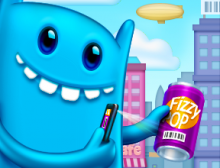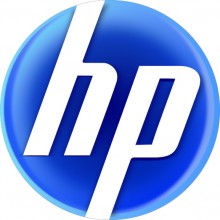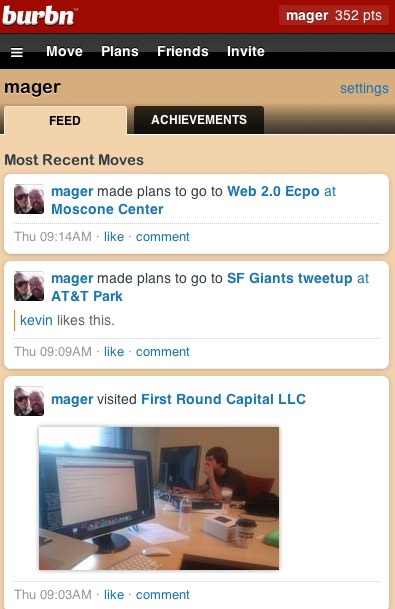
The word ‘pivot’ has become an important part of tech parlance. Switching up your startup’s product and business model when things aren’t going well can be crucial to survival.
Here, in no particular order, are ten notable pivots made by some of the best known tech companies today.
PayPal
 PayPal wasn’t always the popular online payment system we know today. It started life as a product created by a company called Confinity in 1999. At the time, PayPal was designed as a way to “beam” sums of money between PDAs (the smartphones of the day). This Wired interview with Confinity CEO Peter Thiel shows just how ahead of its time the idea was – mobile payments are still ‘the future’ twelve years later.
PayPal wasn’t always the popular online payment system we know today. It started life as a product created by a company called Confinity in 1999. At the time, PayPal was designed as a way to “beam” sums of money between PDAs (the smartphones of the day). This Wired interview with Confinity CEO Peter Thiel shows just how ahead of its time the idea was – mobile payments are still ‘the future’ twelve years later.
Confinity merged with online financial services company X.com in 2000, concentrating on the online financial services side of the business. The merged company initially went by the X.com name. However, PayPal proved a better brand name and the company went on to find a niche as the payment system of choice among eBay sellers before becoming the well-known brand it is today.
Nokia
 Given its recent poor fortunes, some may argue that Nokia should pivot away from mobile phones, but while we know it for its devices these days, the Finnish company actually began as a very different business.
Given its recent poor fortunes, some may argue that Nokia should pivot away from mobile phones, but while we know it for its devices these days, the Finnish company actually began as a very different business.
Nokia’s first enterprise was a paper mill in Tampere, Finland, opened in 1865. Through the early 20th Century, Nokia created a huge variety of products, including rubber boots; cables; consumer electronics; personal computers; electricity generators; robotics; capacitors; military equipment; plastics; aluminium and chemicals. It was only in the 1990s that the company stripped most of that away and focused on telecommunications equipment, eventually transforming it into a mobile phone giant.
 Back in 2005, there wasn’t a go-to place for finding and subscribing to podcasts from around the Web. That’s the hole that Odeo set out to fill, allowing you to create, record, and share podcasts. Unfortunately for founders Noah Glass and Evan Williams, Apple’s iTunes Store moved in to fill that central podcast discovery role in many people’s lives.
Back in 2005, there wasn’t a go-to place for finding and subscribing to podcasts from around the Web. That’s the hole that Odeo set out to fill, allowing you to create, record, and share podcasts. Unfortunately for founders Noah Glass and Evan Williams, Apple’s iTunes Store moved in to fill that central podcast discovery role in many people’s lives.
Spotting the need for change, the company brainstormed possible new directions, one of which was a quirky little messaging service being developed by Jack Dorsey. Odeo’s core team then bought shares in the company back from investors and relaunched as Obvious Corp, which developed a number of products including the messaging app which had gained the name Twttr. By 2007, Twitter (now with added vowels in its name) was become a success and Odeo was sold off. It still exists today as an enterprise video tool – a pivot in itself.
Flickr
Flickr may have lost favor with hardcore photography nuts, but it’s still the photo sharing site of choice for many people, and one of Yahoo’s best-loved properties. It wasn’t always that way though. Flickr started as an MMORPG (massively multiplayer online role playing game) called Game Neverending from Canadian firm Ludicorp.
As the remnants of Ludicorp’s website reveal, Game Neverending featured “a navigable map, real-time interaction with other users, instant messaging, buying, selling and making items and was playable in-browser with no additional downloads, breaking new ground in web application development.”
However, one part of Game Neverending, a tool to share photos and save them to a Web page while playing, turned out to be the most fun part of the experience. Hence Game Neverending was flipped into Flickr which ended up being acquired by Yahoo in 2005. As co-founder Caterina Fake told USA Today in 2006, “Had we sat down and said, ‘Let’s start a photo application,’ we would have failed. We would have done all this research and done all the wrong things.” Sometimes a failed project can be a great learning experience – in this case that certainly held true.

Groupon
You may know Groupon as the behemoth of the daily deals explosion, but it started off as something very different with a fundamentally similar concept. Andrew Mason’s previous site before Groupon was The Point, launched in 2007. The idea was that ‘social good’ campaigns could raise funds from donors who would only have to pay if the funds raised reached the ‘tipping point’ to get the job done, as explained in this video.
The Loving Parent from Groupon, Inc on Vimeo.
Groupon was started as a side project at The Point, launched in late 2008 to apply the same ‘tipping point’ concept to unlocking discounts on activities and services. Perhaps unsurprisingly, the desire amongst the public for daily deals on spa days and Brazilian waxes outweighed its desire to fix up the local park, and Groupon became the main business. Its format quickly spread around the world via a seemingly endless procession of ‘clones’, some of which Groupon bought in order to expand its empire. It’s not all rosy for Groupon though, its business model has faced criticism, and a proposed IPO appears to have been delayed.
Turntable.fm
 The hottest social app idea of the year has got a lot of people (including us) excited. However, Turntable.fm wasn’t always about playing your favorite tunes to a virtual club full of fellow music fans. Until earlier this year, Turntable.fm was an ‘Internet of Things’-focused service called Stickybits.
The hottest social app idea of the year has got a lot of people (including us) excited. However, Turntable.fm wasn’t always about playing your favorite tunes to a virtual club full of fellow music fans. Until earlier this year, Turntable.fm was an ‘Internet of Things’-focused service called Stickybits.
Stickybits allowed users to attach barcodes to objects, which would trigger audio, video, photo, and text messages when they were scanned by a mobile app. Although it was picked up by some brands, Stickybits failed to gain much traction with users. While Turntable.fm has had a delicate relationship with music licensing authorities, it’s certainly captured the imagination of a legion of ‘social DJs’, and the future now looks bring for the New York startup.
HP
 Hewlett Packard is a fascinating company. It started out in 1947 as an engineering company, creating, amongst other things, precision audio oscillators. After producing a range of electrical testing products in its early years, it moved into computing in the 1960s. In 1968, it introduced the world’s first marketed, mass-produced personal computer.
Hewlett Packard is a fascinating company. It started out in 1947 as an engineering company, creating, amongst other things, precision audio oscillators. After producing a range of electrical testing products in its early years, it moved into computing in the 1960s. In 1968, it introduced the world’s first marketed, mass-produced personal computer.
By the 1980s, HP’s computer line had expanded to include printers and scanners, and all its’ equipment was aimed at the business and education markets. It wasn’t until the 1990s, that it began to target consumers with home PCs. This culminated , in 1999, in the spinning off of all its non-computing product lines, such as scientific testing equipment and semiconductors, into a separate company called Agilent. From there, HP was all about computers – this was arguably the company’s first major pivot.
A leading computer manufacturer throughout the first decade of the 20th Century, it acquired Palm in 2010 to expand its reach into further into mobile devices. However, just months after unveiling its first webOS tablet, the HP TouchPad, it announced just last month that ceasing production of mobile devices, and placing doubt on the future of webOS and its entire consumer computing business. Instead, HP would be acquiring UK data analysis firm Autonomy and focusing entirely on the enterprise market.
Nintendo
 Nintendo may be one of the world’s best known video game brands today, but Super Mario and Pokemon weren’t always the company’s focus. The company began as a playing cards manufacturer in late 18th Century Kyoto, Japan, attempting diversification over the next century into areas as diverse as a taxi firm, a TV network, a food company selling instant rice, and a ‘love hotel’ – a type of (very) short stay accommodation popular with Japanese couples looking for privacy in the country’s space-starved cities.
Nintendo may be one of the world’s best known video game brands today, but Super Mario and Pokemon weren’t always the company’s focus. The company began as a playing cards manufacturer in late 18th Century Kyoto, Japan, attempting diversification over the next century into areas as diverse as a taxi firm, a TV network, a food company selling instant rice, and a ‘love hotel’ – a type of (very) short stay accommodation popular with Japanese couples looking for privacy in the country’s space-starved cities.
Moving into the toy market in 1966, Nintendo eventually found its niche producing electronic games, with products like the Game & Watch, and the Famicom games console – not to mention some of the best-loved characters of the past 30 years.
Seesmic
 Today, Seesmic develops social media client apps with a particular focus on enterprise services like Salesforce.com. However, it’s not long ago that the company was a video service, which allowed people to start video discussions, with others offering their own threaded video replies.
Today, Seesmic develops social media client apps with a particular focus on enterprise services like Salesforce.com. However, it’s not long ago that the company was a video service, which allowed people to start video discussions, with others offering their own threaded video replies.
In its first incarnation, Seesmic was supposed to be the ‘Twitter for video’, but it never gained significant traction – most probably because the barrier to entry for contributing was high; recording a coherent message, without tripping over your words, while looking okay too, is so much harder work than writing a short tweet. CEO Loic Le Meur explained the shift to social media clients in a video which appears to no longer work, but that we described as ‘Brutally honest’ back in June 2009.
Instagram is the best-known mobile photo app, boasting in excess of 7 million users and rapid growth, despite still only being available for the iPhone. However, that wasn’t always the plan. Instagram was initially known as Burbn and took in elements of Fourquare, combining them with gaming elements inspired by Mafia Wars.
So, why the switch? As CEO Kevin Systrom has explained on Quora, “We decided that if we were going to build a company, we wanted to focus on being really good at one thing. We saw mobile photos as an awesome opportunity to try out some new ideas. We spent 1 week prototyping a version that focused solely on photos. It was pretty awful.
“So we went back to creating a native version of Burbn. We actually got an entire version of Burbn done as an iPhone app, but it felt cluttered, and overrun with features. It was really difficult to decide to start from scratch, but we went out on a limb, and basically cut everything in the Burbn app except for its photo, comment, and like capabilities. What remained was Instagram.”

Thanks to Eileen Burbidge and Jamie Nathan for their suggestions for this post.
Get the TNW newsletter
Get the most important tech news in your inbox each week.





